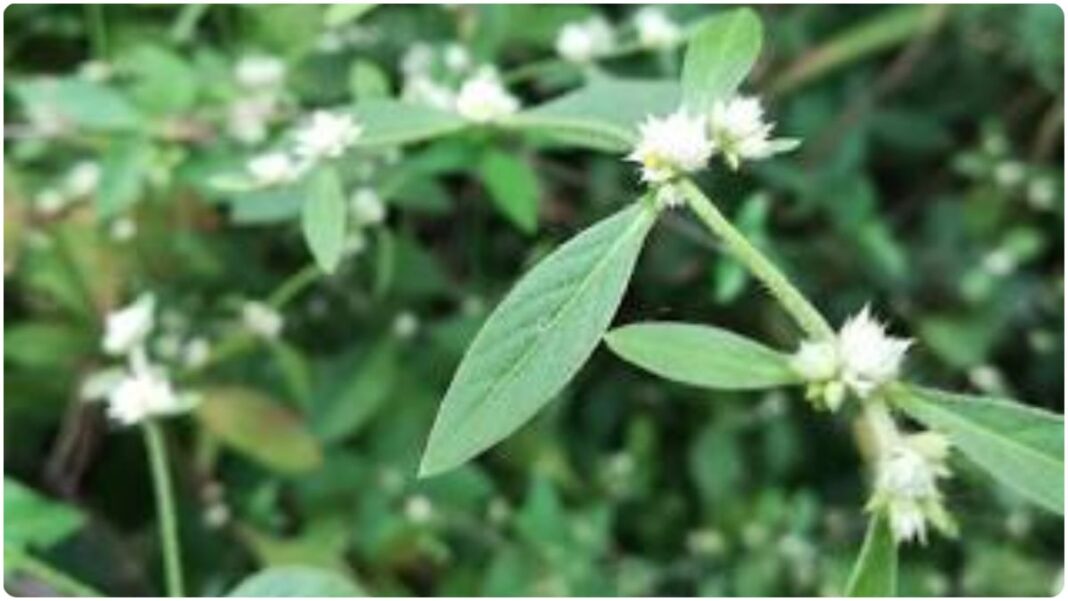We Sri Lankans like to eat vegetables and green leaves that we have used since ancient times and are familiar with. That habit urges our curiosity about garden weeds. When people see some small herbs that look similar to known and edible herbs, they sometimes try to use them for cooking. There is a frightening side to this habit when you identify the wrong species as known herbs and consume it continuously. Alligator weed and Sessilis Joy weed are typical examples of these mismatches.
What is Mukunuwanna/ Sessilis Joy weed?
The botanical name of Mukunnuwanna is Alternanthera sessilis (Amaranthaceae) and is commonly famous as sessile Joy weed, Sissoo Spinach, and Brazilian spinach. This plant spreads over tropical and sub-tropical regions of the world and is cultivated as a vegetable. Mukunnuwanna has adapted to grow on a variety of soil types ranging from poor, sandy, or alkaline soils, to loam or black cotton soils and grows in both seasonally waterlogged areas and areas with extremely dry conditions. A. sessilis is an annual or perennial herb, 0.2-1 meters tall, with strong taproots. The stems are generally prostate, creeping, often rooting at the nodes, cylindrical and slightly hairy, with numerous erect branches. The leaves are simple, opposite, shortly petiolate, or sessile, 0.6-5 cm long and 0.3-1 cm wide. The inflorescences are dense, sessile, silvery-white clusters of compressed spikes in the leaf axils; perianth segments are equal in length, acute, 1.5-2.5 mm long with a short point. These white colour flowers which are attached directly by their base without a stalk or peduncle to the stem and neck of the leaf, are the important identification of A. sessilis.
In Ayurvedic classical text, this plant is mentioned as Matsyakshi, and Ayurveda Pharmacopoeia of India identified the botanical name of Matsyakshi as Alternanthera sessilis. Ayurveda says Matsyakshi has an antimicrobial effect (Krimighna) and a rejuvenation effect (Rasayana). The traditional text of Ayurveda refers to this plant in many drug preparations for several diseases such as Skin disease (Kushta), dysuria (Muthrakrichra), Urinary calculus (Ashmari), Jaundice (kamala), and Ulcers (Vrana). In Sri Lanka, traditional and Ayurvedic practitioners widely used Mukunuwana to treat psychological diseases (Unmada chikitsa) and liver diseases. Overall, the anti-inflammatory, diuretic, anti-diabetic, hematinic, analgesic, and central nerve-stimulating activities of the plant have been proven by researchers. There are published research papers that complete the authentication of the plant. Therefore, Identifying the correct varieties of Mukunuvanna plants and using them as food or medicine will be useful for our health and well-being.
What is an Alligator weed?
The botanical name of the Alligator weed is Alternanthera philoxeroides. It is a low-growing non-woody perennial aquatic or terrestrial plant, an invasive pest plant that is easily spread; originally from Brazil, should have arrived accidentally in New Zealand in the early 1900s and has now spread to parts of northern New Zealand. It has long, fibrous roots and pink, soft, hollow stems (<10 m long) root at nodes, creeps along the ground, or floats on water with upright tips forming dense stands or rafts. Dark green, waxy leaves (3-13 x 1-4 cm) are opposite. Flowers are white, clover-like, and borne on stalks. Clusters (1-2 cm diameter) of this white clover-like flower appear from December to February, but no seed is produced in New Zealand. This flower helps to distinguish alligator weed from MuKunuwanna/ Sessilis Joy weed.
This weed Alters aquatic habitat structure and reduces native plant cover and diversity in wetlands and water body margins. It also displaces valuable pasture species, blocks drainage channels, and exacerbates flooding on farmland. Therefore, the law prohibits breeding, distributing, releasing, or selling alligator weed in New Zealand. Alligator weed is a National Pest Plant Accord species, so these restrictions apply within the Auckland region and across New Zealand. According to most of the regional council’s websites, you should not attempt to undertake control of this species on Aotea/Great Barrier Island group. If seen, you should report to city Councils or Aotea/Great Barrier Island group. Alligator weed flea beetle (Agasicles hygrophila) and Alligator weed stem borer (Arcola malloi) are biocontrol agents against Alligator weed. Most importantly, Alligator weed is a toxic plant and can cause blindness and other health problems if you consume it.
Source: Internet., Ayurvedic pharmacopoeia of India
By Dr (Mrs.) Nadeeka S. Perera – Dunedin








